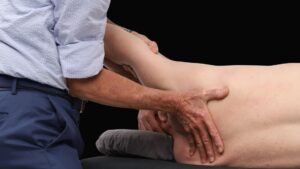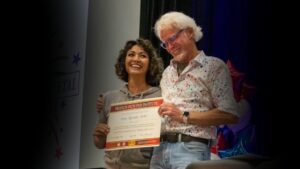Excursion of the Sciatic Nerve During Nerve Mobilization Exercises: An In Vivo Cross-sectional Study Using Dynamic Ultrasound Imaging.
Coppieters MW1, Andersen LS, Johansen R, Giskegjerde PK, Høivik M, Vestre S, Nee RJ.
Abstract
STUDY DESIGN:
Controlled laboratory cross-sectional study using single-group, within-subject comparisons.
OBJECTIVES:
To determine whether different types of neurodynamic techniques result in differences in longitudinal sciatic nerve excursion.
BACKGROUND:
Large differences in nerve biomechanics have been demonstrated for different neurodynamic techniques for the upper limb (median nerve), but recent findings for the sciatic nerve have only revealed small differences in nerve excursion that may not be clinically meaningful.
METHODS:
High-resolution ultrasound imaging was used to quantify longitudinal sciatic nerve movement in the thigh of 15 asymptomatic participants during 6 different mobilization techniques for the sciatic nerve involving the hip and knee. Healthy volunteers were selected to demonstrate normal nerve biomechanics and to eliminate potentially confounding variables associated with dysfunction. Repeated-measures analyses of variance were used to analyze the data.
RESULTS:
The techniques resulted in markedly different amounts of nerve movement (P<.001). The tensioning technique was associated with the smallest excursion (mean ± SD, 3.2 ± 2.1 mm; P < or = .004). The sliding technique resulted in the largest excursion (mean ± SD, 17.0 ± 5.2 mm; P<.001), which was approximately 5 times larger than that resulting from the tensioning technique and, on average, twice as large as that resulting from individual hip or knee movements.
CONCLUSION:
Consistent with current theories and findings for the median nerve, different neurodynamic exercises for the lower limb resulted in markedly different sciatic nerve excursions. Considering the continuity of the nervous system, the movement and position of adjacent joints have a large impact on nerve biomechanics.
J Orthop Sports Phys Ther. 2015 Oct;45(10):731-7. doi: 10.2519/jospt.2015.5743. Epub 2015 Aug 24.
• 1Faculty of Behavioural and Movement Sciences, MOVE Research Institute Amsterdam, VU University Amsterdam, Amsterdam, the Netherlands.
Comparison of longitudinal sciatic nerve movement with different mobilization exercises: an in vivo study utilizing ultrasound imaging.
Ellis RF1, Hing WA, McNair PJ.
J Orthop Sports Phys Ther. 2012 Aug;42(8):667-75. doi: 10.2519/jospt.2012.3854. Epub 2012 Jun 18.
Abstract
STUDY DESIGN:
Controlled laboratory study using a single-group, within-subjects comparison.
OBJECTIVES:
To determine whether different types of neural mobilization exercises are associated with differing amounts of longitudinal sciatic nerve excursion measured in vivo at the posterior midthigh region.
BACKGROUND:
Recent research focusing on the upper limb of healthy subjects has shown that nerve excursion differs significantly between different types of neural mobilization exercises. This has not been examined in the lower limb. It is important to initially examine the influence of neural mobilization on peripheral nerve excursion in healthy people to identify peripheral nerve excursion impairments under conditions in which nerve excursion may be compromised.
METHODS:
High-resolution ultrasound imaging was used to assess sciatic nerve excursion at the posterior midthigh region. Four different neural mobilization exercises were performed in 31 healthy participants. These neural mobilization exercises used combinations of knee extension and cervical spine flexion and extension. Frame-by-frame cross-correlation analysis of the ultrasound images was used to calculate nerve excursion. A repeated-measures analysis of variance and isolated means comparisons were used for data analysis.
RESULTS:
Different neural mobilization exercises induced significantly different amounts of sciatic nerve excursion at the posterior midthigh region (P<.001). The slider exercise, consisting of the participant performing simultaneous cervical spine and knee extension, resulted in the largest amount of sciatic nerve excursion (mean ± SD, 3.2 ± 2.0 mm). The amount of excursion during the slider exercise was slightly greater (mean ± SD, 2.6 ± 1.5 mm; P = .002) than it was during the tensioner exercise (simultaneous cervical spine flexion and knee extension). The single-joint neck flexion exercise resulted in the least amount of sciatic nerve excursion at the posterior midthigh (mean ± SD, -0.1 ± 0.1 mm), which was significantly smaller than the other 3 exercises (P<.001).
CONCLUSION:
These findings are consistent with the results of previous research that has examined median nerve excursion associated with different neural mobilization exercises. Such nerve excursion supports theories of nerve motion associated with cervical spine and extremity movement, as generalizable to the lower limb.
Different nerve-gliding exercises induce different magnitudes of median nerve longitudinal excursion: an in vivo study using dynamic ultrasound imaging.
Coppieters MW1, Hough AD, Dilley A.
J Orthop Sports Phys Ther. 2009 Mar;39(3):164-71. doi: 10.2519/jospt.2009.2913.
Abstract
STUDY DESIGN:
Controlled laboratory study using single-group, within-subject comparisons.
OBJECTIVES:
To determine in an in vivo study whether different types of nerve-gliding exercises are associated with different amounts of longitudinal nerve excursion.
BACKGROUND:
Different types of nerve-gliding exercises have been proposed. It is assumed that different exercises produce different amounts of excursion and strain in the peripheral nervous system. Although this has been confirmed in cadaveric experiments, in vivo studies are lacking.
METHODS:
High-resolution ultrasound was used to measure longitudinal excursion of the median nerve in the upper arm during 6 different nerve-gliding exercises. Nerve mobilization techniques that involved the elbow and neck were evaluated in 15 asymptomatic volunteers (mean +/- SD age, 30 +/- 8 years). Nerve longitudinal excursion was calculated using a frame-by-frame cross-correlation analysis. A repeated-measures analysis of variance was used to analyze the data.
RESULTS:
Different exercises induced different amounts of longitudinal nerve excursion (P<.0001). The “sliding technique” was associated with the largest excursion (mean +/- SD, 10.2 +/- 2.8 mm; P = .0001). The amount of nerve movement associated with the “tensioning technique” (mean +/- SD, 1.8 +/- 4.0 mm) was smaller than the nerve excursion induced with individual movements of the neck or elbow (mean +/- SD range, -3.4 +/- 0.9 to 5.6 +/- 2.1 mm; P = .0001).
CONCLUSION:
These findings confirm that different types of neurodynamic techniques have different mechanical effects on the nervous system. Recognition of these differences may assist in the selection of treatment techniques. Having demonstrated differences in mechanical effects, future research will have to evaluate whether these different techniques are also associated with different physiological and therapeutic effects.









